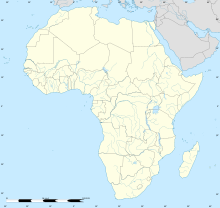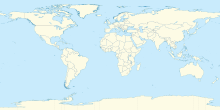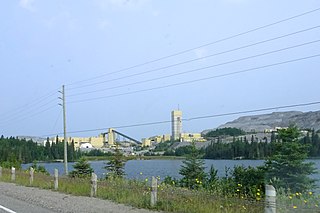
Barrick Gold Corporation is a mining company that produces gold and copper with 16 operating sites in 13 countries. It is headquartered in Toronto, Ontario, Canada. It has mining operations in Argentina, Canada, Chile, Côte d'Ivoire, Democratic Republic of the Congo, Dominican Republic, Mali, Papua New Guinea, Saudi Arabia, Tanzania, the United States and Zambia. In 2019, it produced 5.5 million ounces of gold at all-in sustaining costs of $894/ounce and 432 million pounds of copper at all-in sustaining costs of $2.52/pound. As of 31 December 2019, the company had 71 million ounces of proven and probable gold reserves.
Placer Dome Inc. was a large mining company specializing in gold and other precious metals, with corporate headquarters in Vancouver, British Columbia, Canada.

Xstrata plc was an Anglo-Swiss multinational mining company headquartered in Zug, Switzerland and with its registered office in London, United Kingdom. It was a major producer of coal, copper, nickel, primary vanadium and zinc and the world's largest producer of ferrochrome. It had operations in 19 countries across Africa, Asia, Australasia, Europe, North America and South America.

Kahama Urban District is one of the five districts of the Shinyanga Region of Tanzania. Its administrative centre is the town of Kahama. It is bordered to the north and south by Kahama Rural District, to the east by Nzega District and to the west by Bukombe District.
John Lawson Thornton is an American businessman and professor and director of the Global Leadership Program at Tsinghua University in Beijing. He is also executive chairman of Barrick Gold Corporation and non-executive chairman of PineBridge Investments. Thornton stepped down as co-president of Goldman Sachs in 2003.

The Porgera Gold Mine is a large gold and silver mining operation in near Porgera, Enga province, Papua New Guinea (PNG), located at the head of the Porgera Valley. The mine is situated in the rain forest covered highlands at an altitude of 2,200 to 2,700 m, in a region of high rainfall, landslides, and frequent earthquakes.

China National Gold Group Corporation (中国黄金集团有限公司) is a centrally state owned Chinese gold corporation primarily engaged in the mining and refining of gold, silver, copper, and molybdenum.
There are different methods by which gold mining companies are ranked. One is by their annual production. Another is by their cash cost per ounce, that is, how much money it costs them to mine the gold. Since gold prices are the same everywhere, companies with lower costs per ounce make more profit. The most common method lists by market capitalization which considers the total value of capital holdings by that company. Also considered when comparing companies is their market capitalization per ounce of gold equivalent which takes the market value and total reserves and resources for each company as well as the price of gold into consideration. The figures for each company can be used to determine the value the stock market gives to each company's reserves on an ounce to ounce basis.
Acacia Mining is a gold mining business operating in Tanzania, with exploration properties in Kenya, Burkina Faso and Mali. It is listed on the London Stock Exchange and the Dar es Salaam Stock Exchange and is a constituent of the FTSE 250 Index until it was re-acquired by Barrick Gold in September 2019.
The Sekenke Gold Mine was an underground gold mine in the Singida Region of Tanzania.
Tulawaka Gold Mine was a combined underground and open pit gold mine located in the Biharamulo district, in the Kagera Region of Tanzania. It is operated by African Barrick Gold, who owned 70% of the mine. The remaining 30% was owned by MDM Mines.
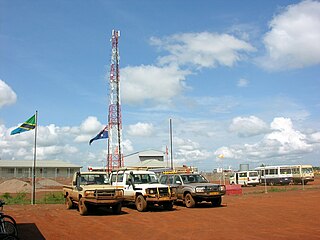
Buzwagi Gold Mine is an open pit gold mine in the Shinyanga Region of Tanzania, located 6 kilometres southeast from the town of Kahama. It is operated by Acacia Mining.
North Mara Gold Mine is a combined open pit and underground gold mine in the Tarime District of the Mara Region of Tanzania. It is one of three gold mines of Acacia Mining plc, a company listed on the London Stock Exchange, that operates in Tanzania, the other two being Bulyanhulu and the Buzwagi Gold Mine.
The Kirondatal Gold Mine was a gold mine in the Singida Region of Tanzania.
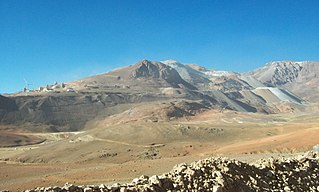
Pascua-Lama is an open pit mining project of gold, silver, copper and other minerals. Pascua Lama is located in the Andes mountains, in the southern reaches of Atacama Desert, straddling the border between Chile and Argentina at an altitude of over 4,500 metres. Toronto-based Barrick Gold, the world's largest gold mining company, is developing the project. Due to its proximity to glaciers, Pascua-Lama has caused controversy and public protest in Chile, including demonstrations and petitions presented to the Chilean government. Chile has not approved the project.

Kahama is a town in north-western Tanzania. The town serves as the headquarters of Kahama Urban District.
Canadian mining in Latin America and the Caribbean began in the 20th century. Latin America and the Caribbean's vast resources give the region great geopolitical importance, attracting foreign interest for centuries. From the colonial race of European empires, to the multinationals of today's neoliberal capitalist world, this region continues to draw interest. Canada's involvement in Latin America increased dramatically since 1989 with several landmark negotiations and agreements. By 2009, the Canadian larger-company mineral exploration market in this region was valued at US$1.7 billion.
Shandong Gold Group is a state-owned Chinese gold mining company under the provincial government of Shandong. The company is the second-largest producer of gold in China by output and its publicly-listed subsidiary ranked #1,898 in the Forbes Global 2000.

Alain Deneault is a French Canadian author from Quebec. He is known for his book Noir Canada: Pillage, corruption et criminalité en Afrique and the legal proceedings that followed its publishing.

